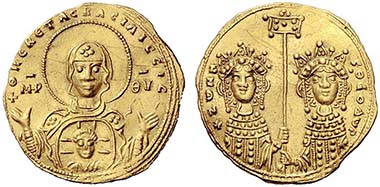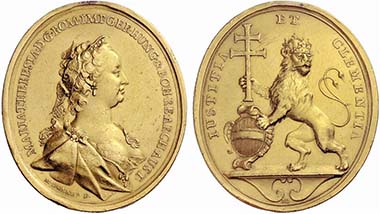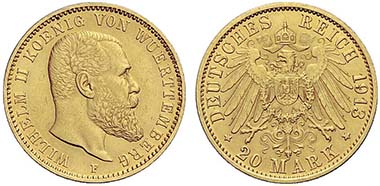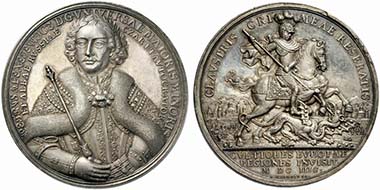11-12-2011 – 01-01-1970
Auction 153 – Numismatic Rarities
Numismatic Rarities at auction house Lanz – the results
Auction 153 of Numismatik Lanz Munich on December 12, 2011, was devoted to “Numismatic Rarities”. In line with expectations, many collectors were present and took the opportunity to choose their special Christmas present from an equally rich as high-quality offer. Pre-Christmas was likewise the number of modest estimates that enabled everyone to enrich the collection by a very special piece.
No. 706: BYZANTINE COINS. Zoe and Theodora (April-June 1042). Histamenon nomisma, 1042, Constantinopolis. DOC 1. Of greatest rarity. Extremely fine. Realized: 50,000 euros.
Let’s restrict ourselves to the auction highlights! 50,000 euros was the bidding when the auction hammer went down for the most expensive coin of the sale: a histamenon of the Byzantine empresses Zoe and Theodora from their short joint reign in 1042, of great historical interest, very rare and in an extremely fine state of preservation (no. 706).
With 36,000 euros “second place” got a gold diobol from the Sicilian city of Syracuse (no. 134, extremely fine). This coin as well was minted only for a short period of time, between 214 and 212 B. C., during the so-called 5th Republic, before the city was conquered by the Romans and consequently lost its political autonomy. The list of items that yielded five-figure prices is impressive in itself. One of these items is (of course) a magnificent electrum 1/6 stater from the beginnings of Greek coining in Ionia showing a bridled horse on its obverse (no. 256, 10,000 euros). A likewise very rare aureus of young Caracalla from a Syrian mint with a tropaion on the reverse, which is reminiscent of the victory of his father Septimius Severus in the war against Parthia, brought 15,000 euros (no. 492, extremely fine). A splendidly preserved solidus of Irene, first empress regnant in the Byzantine throne, found an equally happy as proud new owner for 13,500 euros (no. 701, brilliant uncirculated).
No. 738: AUSTRIA. Maria Theresia (1740-1780). Gnadenmedaille of 14 ducats n. d. (M. Donner, Vienna) on the Bohemian Coronation. Holzmair 29 (in gold not verifiable). Realized: 11,000 euros.
Not only the ancient empresses enjoyed greatest popularity – at least with collectors –, a gnadenmedaille of 14 Ducats of Maria Theresia by M. Donner on the Bohemian Coronation (no. 738, very fine) achieved a remarkable result with its price of 11,000 euros – the more so because the estimate of 6,000 was almost doubled.
No. 790: GERMAN EMPIRE. Wuerttemberg, William II (1891-1918). 20 mark 1913, Stuttgart. Jaeger 296. Very rare. Very fine / extremely fine. Realized: 16,500 euros.
Likewise a “bestseller” was one of the rarest gold coins of the German Empire, the Wuerttemberg 20 mark piece 1913 F in very fine to extremely fine (no. 790, 16,500 euros).
Traditionally, auction house Lanz has a strong clientele in Italy. That is testified by the results achieved in this section. Not a single piece was returned. And an extremely rare testone of Carlo Giovanni Amadeo, who, as duke, ruled over Savoy from 1490 to 1496 (no. 818, very fine), became third most expensive coin of the auction with its price of 18,000 euros. However, it shared this place with a Russian silver coin:
No. 890: RUSSIA. Grand Duchy of Moscow. Peter I the Great (1689-1725). Quintuple schautaler 1697 (by Christian Wermuth), on his first visits to Europe. Diakov 6.1. Very rare. Very fine. Realized: 18,000 euros.
A very rare quintuple schautaler of Peter the Great by Christian Wermuth, minted in 1697 on his first visits to Europe (no. 890, very fine) increased sixfold its estimate of not more than 3,000 euros.
These were just a few highlights of the auction of Numismatik Lanz. We already wonder what auction house Lanz will keep for sale for us next year. For anyone unable to wait until then: Numismatik Lanz continuously conducts auctions at eBay. For checking it out please click here.
The results of auction 153 can be viewed at the website of Numismatik Lanz.







